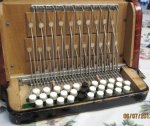KLR
Active member
- Joined
- Jul 3, 2013
- Messages
- 112
- Reaction score
- 13
Some Irish button accordion players take the grille off their instruments entirely, to let nothing get in the way of the sound projecting. I've seen a few examples of grilles which had more slots cut into them by their owners, same thinking. How about a grille that would operate like an old rolltop desk? 
A slide mute was mentioned earlier, I've seen a couple examples of mutes which were solid pieces of wood that you could slide under the grille to mute the sound. How about a hollow grille, with a perforated front portion you could slide into place if so desired?
A slide mute was mentioned earlier, I've seen a couple examples of mutes which were solid pieces of wood that you could slide under the grille to mute the sound. How about a hollow grille, with a perforated front portion you could slide into place if so desired?

